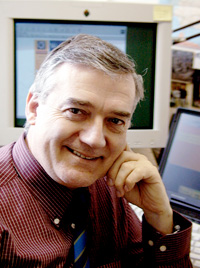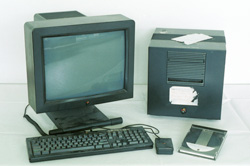"What began as a ninth-grade prank, a way to trick already-suspicious friends who had fallen for his earlier practical jokes, has earned Rich Skrenta notoriety as the first person to let loose a personal-computer virus.
Although Skrenta over the next 25 years started the online news business Topix, helped launch a collaborative Web directory now owned by Time Warner Incorporated’s Netscape and wrote countless other computer programs, he is still remembered most for unleashing the ‘Elk Cloner’ virus on the world.
‘It was some dumb little practical joke,’ said Skrenta, 40. ‘I guess if you had to pick between being known for this and not being known for anything, I’d rather be known for this. But it’s an add place holder for (all that) I’ve done.’
Elk Cloner - self-replicating, as are all other viruses - bears little resemblance to the malicious programs of today. Yet in retrospect, it was a harbinger of all the security headaches that would only grow as more people got computers - and connected them with one another over the Internet.
Skrenta’s friends were already distrusting him because, in swapping computer games and other software, as part of piracy circles common at the time, Skrenta often altered the floppy disks he gave out to launch taunting on-screen message. Many friends started refusing disks from him.
So, during a winter break from Mount Lebanon Senior High School near Pittsburgh, Skrenta hacked away and figured out how to get the code to launch the messages onto disks automatically.
He used his Apple II, the dominant personal computer of the day, to develop what is now known as a ‘boot sector’ virus. When it boots, or starts, an infected disk puts a copy of the virus in the computer’s memory. Whenever someone inserts a clean disk into the machine and types the command ‘catalog’ for a list of files, a copy is written onto that disk as well. The newly infected disk is passed on to other people, other machines and other locations.
The prank, though annoying, is relatively harmless compared with the viruses of today. Every 50th time someone booted an infected disk, a poem Skrenta wrote would appear, saying in part, ‘It will get on all your disks; it will infiltrate your chips.’
Skrenta started circulating the virus in early 1982 among friends at his school and at a local computer club. Years later, he would continue to hear stories of other victims, including a sailor during the Gulf War nearly a decade later. (Why that sailor was still using an Apple II, Skrenta can’t say.)
These days, there are hundreds of thousands of viruses - perhaps more than a million depending on how slight variations are counted.
The first virus to hit computers running Microsoft’s operating system came in 1986, when two brothers in Pakistan wrote a boot sector program now dubbed ‘Brain’ - purportedly to punish people who spread pirated software. Although the virus didn’t cause serious damage, it displayed the phone number of the brothers’ computer repair shop.
With the growth of the Internet came a new way to spread viruses: e-mail.
‘Melissa’ (1999), ‘Love Bug’ (2000) and ‘SoBig’ (2003) were among a slew of fast-moving threats that snarled millions of computers worldwide by tricking people into clicking on the e-mail attachments and launching programs that automatically sent copies to other victims.
Although some of the earlier viruses overwhelmed networks, later ones corrupted documents or had other destructive properties.
Later viruses spread through instant-messaging and file-sharing software, while others circulated faster than ever by exploiting flaws in Windows networking functions.
Suddenly, though, viruses weren’t spreading as quickly. Virus writers now motivated by profit rather than by notoriety are trying to stay low-key, lest their creations get detected and removed, along with their mechanism for income.
Even as corporations and Internet service providers step up their defenses, virus writers look to emerging platforms, including mobile devices and Web-based services such as social-networking sites.
That’s not to say Skrenta should get the blame anytime someone gets spam sent through a virus-enabled relay or finds a computer slow to boot because of a lingering pest. After all, there's no evidence that virus writers who followed even knew of Skrenta or his craft.
Fred Cohen, a security expert who wrote his doctorate dissertation in 1986 about computer viruses, said that the conditions were right, and that, with more homes getting computers, ‘it was all a matter of time before this happened.’
So, back then, where was Skrenta’s restraint?
‘I was in the ninth grade,’ he said.”
| 25 Years of Viruses |
| | |
| Elk Cloner, 1982 | Regarded as the first |
| Morris, 1988 | Written by a Cornell graduate student whose father was a top government computer-security expert. It infected an estimated 6,000 university and military computers. |
| Melissa, 1999 | One of the first to spread via e-mail. |
| Love Bug, 2000 | Also spread via e-mail. It tricked recipients into opening it by looking like a love letter. |
| Code Red, 2001 | Exploiting a flaw in Microsoft software, it was among the first ‘network worms’ to spread rapidly because it required only a network connection, not a human opening an attachment. |
| Sasser, 2004 | Exploited a Microsoft flaw. Bad programming prompted some computers to continually crash and reboot |
Labels: World First























